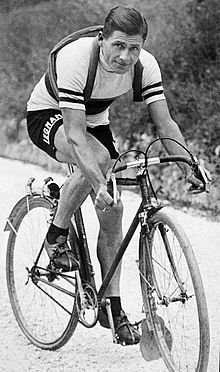Alfredo Binda
 | ||||||||||||||||||||||||
| Personal information | ||||||||||||||||||||||||
|---|---|---|---|---|---|---|---|---|---|---|---|---|---|---|---|---|---|---|---|---|---|---|---|---|
| Born | 11 August 1902 Cittiglio, Italy | |||||||||||||||||||||||
| Died | 19 July 1986 (aged 83) Cittiglio, Italy | |||||||||||||||||||||||
| Team information | ||||||||||||||||||||||||
| Discipline | Road | |||||||||||||||||||||||
| Role | Rider | |||||||||||||||||||||||
| Rider type | Climber, classics specialist | |||||||||||||||||||||||
| Professional teams | ||||||||||||||||||||||||
| 1922 | Nice Sport | |||||||||||||||||||||||
| 1923–1924 | La Française | |||||||||||||||||||||||
| 1925–1927 | Legnano | |||||||||||||||||||||||
| 1928 | Legnano/Mifa | |||||||||||||||||||||||
| 1929–1936 | Legnano | |||||||||||||||||||||||
| Major wins | ||||||||||||||||||||||||
Grand Tours
| ||||||||||||||||||||||||
Medal record
| ||||||||||||||||||||||||
Alfredo Binda (11 August 1902 – 19 July 1986)[1][2] was an Italian cyclist of the 1920s and 1930s. He was the first to win five editions of the Giro d'Italia, and a three-time world champion. In addition he won Milan–San Remo twice, and the Tour of Lombardy four times.
Later he would manage the Italian National team. Under him, Fausto Coppi, Gino Bartali and Gastone Nencini all triumphed at the Tour de France.
Early life
Binda was born in Cittiglio near Varese but moved to Nice, in southern France as a teenager. He found work with his uncle as an apprentice plasterer, but he and brother Primo spent their free time cycling. He began racing in September 1921, aged 19. He won his first race (though he was subsequently disqualified) and it was clear from the outset that he was immensely gifted as both time trialist and climber.
Binda was a trained trumpet player, and was nicknamed "Trombettiere di Cittiglio" ("The Trumpeter of Cittiglio").[3]
Cycling career
Enticed by a 500 lire King of the Mountains prize on the Ghisallo climb, Binda rode from Nice to Milan in order to compete in the 1924 Tour of Lombardy. He won the prize, finished fourth in the race, and was immediately offered a contract with the Legnano professional team.
The 1925 Giro d'Italia was to be the last of the legendary campionissimo Costante Girardengo. All of Italy hoped he would prevail, and his defeat at the hands of Binda, a 23-year-old Giro debutant, was deeply unpopular. In the event Girardengo resolved to continue racing, and the two of them developed a caustic, deeply personal rivalry. As Girardengo's powers waned, Italians looked to Domenico Piemontesi to usurp Binda but, much like everyone else, he was hopelessly out of his depth against the fuoriclasse.
In 1929 Girardengo "discovered" a prodigiously strong track rider from Veneto, Learco Guerra. He famously anointed him as his heir apparent, a new "anti-Binda". Guerra closely resembled Girardengo as a cyclist, and was hugely popular. He enjoyed the support of the Italian Fascist Party, and by extension the press and wider sporting public. Binda, on the other hand, famously declared that he'd no interest in producing spettacolo. Rather he was simply in the business of winning bike races, and each time he defeated Guerra the Italian public's antipathy grew. Whilst Guerra was homespun, expansive and open, Binda was perceived as cold and detached, pompous even.
So dominant was he that the Gazzetta dello Sport offered him 22,500 lire to miss the Giro of 1930. Instead, he took part in that year's Tour de France, winning two stages. Not until 1932, when he won a third Cycling World Championship in Rome, did the public start to warm to him. By then he had redefined both training and racing methodology, and was inarguably the greatest cyclist ever to have lived.
All told he won the Giro a record five times in 1925, 1927, 1928, 1929 and 1933 (1933 was also the first year the Giro held a "King of the Mountains" competition, which Binda won too). Besides the overall victories he won 41 stages (a record only broken in 2003 by Mario Cipollini). In 1927, he won 12 out of 15 stages, and in 1929 he won 8 consecutive stages.
In the World Championships, Binda was also very successful. He won the title three times in 1927, 1930 and 1932 (a record later equalled by Rik Van Steenbergen, Eddy Merckx and Óscar Freire). In addition, he placed third in 1929. By the time he retired he had won over 120 races, including the Italian Championships four times.
Società Ciclistica Alfredo Binda is named in his honor.[4]

Major results
Source:[5]
- 1925
- Giro d'Italia:
- Giro di Lombardia
- 1926
- Giro di Lombardia
- Giro del Piemonte
- Giro d'Italia:
- Winner stages 3, 6, 7, 9, 11 and 12
 Italian National Road Race Championship
Italian National Road Race Championship- 1927
- Giro d'Italia:
- World Road Cycling Championships
- Giro di Lombardia
- Giro del Piemonte
 Italian National Road Race Championship
Italian National Road Race Championship- 1928
- Giro d'Italia:
- Giro del Veneto
 Italian National Road Race Championship
Italian National Road Race Championship- 1929
- Giro d'Italia:
- Milan–San Remo
 Italian National Road Race Championship
Italian National Road Race Championship- 1930
- World Road Cycling Championships
- Tour de France:
- Winner stages 8 and 9
- 1931
- Milan–San Remo
- Giro di Lombardia
- Giro d'Italia:
- Winner stages 3 and 4
- 1932
- World Road Cycling Championships
- 1933
- Giro d'Italia:
 Winner overall classification
Winner overall classification Winner King of the Mountains classification
Winner King of the Mountains classification- Winner stages 2, 8, 9, 10, 13, 17
References
- ^ l'Unita. 20 July 1986. p. 22
- ^ l'Unita. 22 July 1986. p. 18
- ^ Alfredo Binda Photo Gallery. bikeraceinfo.com
- ^ "Tre Valli Varesine". Società Ciclistica Alfredo Binda Varese.
- ^ Alfredo Binda at Cycling Archives (archive)
